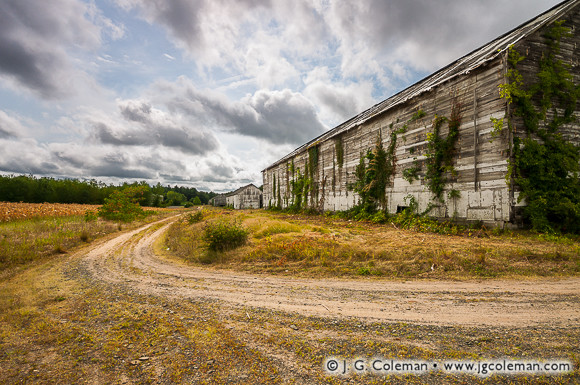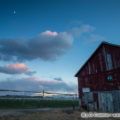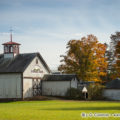
I recently read the latest blog post by landscape photographer Jake Peterson titled, The Importance of Shooting Everyday, in which he lamented the unexpected demolition of a beautiful barn which he had sadly photographed only once before it was gone forever.
That got me thinking about some of the old, derelict tobacco barns in North-Central Connecticut that I began photographing last year after I conceived of the idea for my Tobacco Valley project. Take this row of barns along a dusty dirt road in Bloomfield (photo at top) which I photographed just last summer under some beautiful cloud cover. Tobacco barns such as these (or “tobacco sheds”, as they are more properly termed) would’ve been built around the 1920s or 1930s, give or take a decade, and they were used to cure tobacco after it had been harvested in late summer. But that was during the “golden age” of Connecticut tobacco, when broadleaf and shade tobacco were being raised on no less than 30,000 acres of the Connecticut River Valley. These days, that number has dwindled to just 3,000 acres, only about a tenth of its former glory.

As the market for Connecticut tobacco declined, massive fields were sold off, bulldozed and covered over with neighborhoods and office buildings… they were erased from the landscape as if they had never been there. Yet, in scattered pockets throughout Northern Connecticut, the enormous, surplus barns that once housed each year’s harvest have managed to remain standing even after generations of neglect —even as most of the farmland that once surrounded them vanished beneath corporate office parks or young forests.
That some of these abandoned barns are still standing after all these years is a testament to their sturdy construction. Despite leaky roofs, decaying siding and the relentless advance of prying vines, they’ve stubbornly carried on weathering the harsh elements of New England. I’ve even found one old tobacco shed in East Windsor which is literally nothing more than a skeleton draped with vines (photo above); somehow it continues to stand squarely in place, even though the tobacco fields surrounding it were replaced long ago by a Christmas tree farm.
But for all of their admirable resilience, these relics of a bygone era are no match for the callous onslaught of progress, a force which still topples them all too often. Remember the barns in Bloomfield from the first photograph up top? Just weeks after I produced that piece, I drove by the spot only to discover that the tobacco barns had vanished. All that remained in their place was an open expanse of graded soil, prepped for the construction of some untold building or parking lot.

Returning to Jake Peterson’s article, the lesson he took away from the sudden loss of his beautiful barn was that photography can, and ought to be, more than just a quest to make a pretty picture. “I started thinking about all the images that I have in my files of places, things and people that are no longer around. While it saddens me,” he writes,” there is relief in knowing that there is at least an image capturing them. We as photographers have an obligation to constantly be shooting and to constantly be sharing. Photography is not just about making beautiful images, but also about preserving history.”
Indeed, every time I find myself standing before some of these decrepit, weather-beaten tobacco barns, the thought lingers in my mind that I may be the last person to photograph them before they finally come crumbling down, either by the rigors of time or the brute force of the bulldozer. And while it’s difficult to see a chapter of our agricultural heritage fade away before my eyes, I am privileged to have the opportunity to memorialize it in some small way. I plan to make the most of that opportunity before it’s too late.





